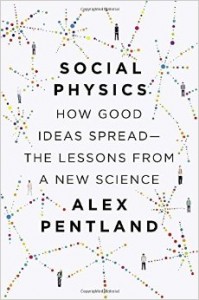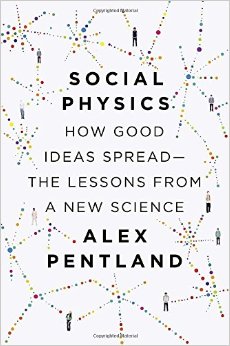I had the good fortune to be following Alex “Sandy” Pentland at the APQC Knowledge Management Conference last May. I was somewhat aware of his work, but great to be able to sit down and really pay attention. He gave an excellent talk around his new book on Social Physics. The two key takeaways I jotted down at the time:
- The importance and functioning of a social network (equality participation) is a huge predictor of effective performance

- Incentivizing network behavior is way better than incentivizing individual behavior
It inspired me to get and read the book, so I thought I’d share a few reflections.
First, what is social physics? He says it “helps us understand how ideas flow from person to person through the mechanism of social learning and how this flow of ideas ups up shaping the norms, productivity, and creative output of our companies” (p4) And Big Data is the engine driving social physics.
The two most important concepts: (p15)
- Idea flow within social networks and how it can be separated into exploration (finding) and engagement (coordinating)
- Social learning, which is how new ideas become habits, and how learning can be accelerated and shaped by social pressure
He notes a key assumption is that we learn from the example of other people’s behavior (sorta like monkey see, monkey do)
He suggests that the best ideas come from “careful and continuous social exploration” rather than long geniuses thinking things up. This “exploration” capability is the key characteristic of people who come up with good ideas, i.e., they are always on the lookout and exploring. They develop and cultivate diverse networks of people and maintain engagement with them. How about a formula — the best strategy is 90% exploration and 10% contemplation.
On the engagement piece, his research suggests we focus on changing the connections between people rather than focusing on getting people to individually c
hange their behavior (peer group influence is strong). Engagement requires repeated interactions to build the trust and ultimately change the behavior.
An interesting thought on group intelligence: “the largest factor in predicting group intelligence was the equality of conversational turn-taking….second was the social intelligence of a group’s members, as measured by their ability to read each other’s social signals.” (p88)
He shares plenty of examples and stories of how he came to his conclusions. For instance, he talked about a study exploring the adoption of smartphone apps among friends and family. They gathered eighteen months of data, noting all communications by whatever means, including apps downloaded every six minutes among small communities of young families, and found that exposure to peer behavior was the best predictor of which apps people would download. In other words, understanding of the social networks proved to be the most useful predictor of technological adoptions! Andy Hines

Leave a Reply